Oct 15, 2025
Oct 15, 2025
“Of Death begrimed and black —
Scattering plagues and sorrows,
Dancing mad with joy,
Come, Mother, come!
For Terror is Thy name,
Death is in Thy breath,
And every shaking step
Destroys a world for e'er.
Thou "Time", the All-Destroyer!
Come, O Mother, come!
Who dares misery love,
And hug the form of Death,
Dance in Destruction's dance,
To him the Mother comes.”
(“Kali, The Mother” by Svami Vivekananda, 1898)
Mother Kali! Who could have expressed better than Shri Ramakrshna’s disciple?
And I cannot but remember those lines by Svami Vivekananda when I am about to narrate my tryst with Kankaleshwari Kali (“Skeleton Kali”) – a unique Sculpture of archeological, historical and religious importance. When Mahakavyas and Puranas blend with History, Archeology and Art, the attraction becomes irresistible.
My better half, Jana, found Her on the net on 14th January 2017, and the very little information that we got courtesy some blogs and stray notes on Kankaleshwari Kali was enough for us to execute our visit the very next day.
Both of us have been almost regular visitors to Burdwan for our professional matters for over the last two decades; and strangely, Kankaleshwari never registered in our mind. In fact, we have always known of several Kali temples of Burdwan, but they had always been under the category of “etc” of places to visit in Burdwan.
This, and many other similar incidents have led me to believe that our Life indeed follows a Script; and the Script unfolds only when Time endows us with the right frame of mind.
Some words on Burdwan first before we travel there …
Burdwan is a historic town that found first mention in a 6th century copper plate, found in a village named Malla Sarul. Abul Fazal referred to the area as Sharifabad. Burdwan (pronounced so by the British) is actually Bardhaman that gained the name from the Jain Guru Tirthankar Vardhaman, who was born here.
In the mid- 17th century, Sangam Rai, a young businessman from Punjab founded the Rai dynasty here. Krishnaram Rai, the last Maharaja of Burdwan was in power till 1955.
Other than Kankaleshwari Kali Temple of Kanchan Nagar, there are several Kali-temples around Burdwan – like, Sarbamangala Kali Mandir, Vidya Sundar Kali Mandira, Foujdari Kali Mandir, Sadhak Kamalakanta Kali Mandir, etc. which shows Tantrik, and therefore, Buddhist influence too over the region.
The Jain influence over the region as suggested in the very name of Burdwan becomes important in understanding Kankaleshwari Kali, because She is Chamunda, a very remarkable Devi of Puranas and Tantra establishing cultural link between Vedic-Hinduism, Jainism and Buddhism. In short, Burdwan is a cultural and religious melting pot, and Kankaleshwari Kali symbolizes that.
Our journey to Kanchannagar began early morning. Reaching Burdwan by local train, we hired an auto from the railway station for Rs.160 back and forth including waiting charge.
Kanchan Nagar was a headquarter of King Shashanka (590 to 625 CE), a contemporary king of Harsa of Kanauj. Bengal was then Gour-Banga. Therefore, this region has to be fertile ground for Archeology; though little has been found and more is yet to be found.
Our auto initially passed through busy and congested roads almost brushing the passing vehicles. The Burdwan Auto and Toto drivers have uncanny skill to negotiate traffic.
As we reached Kanchannagar, a large Gate welcomed us. The right side of the Gate nicely depicts a farmer or labourer couple.
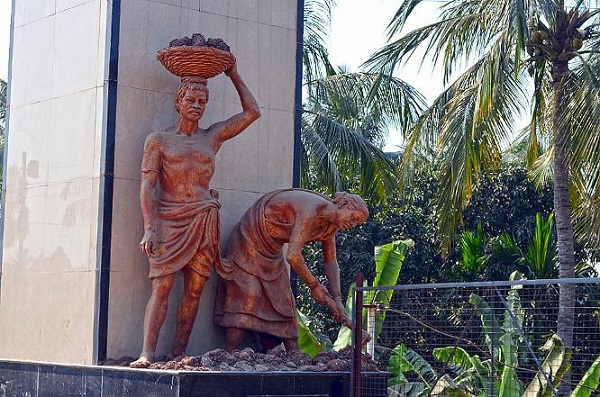
Kanchannagar Gate
Finally, crossing two bridges, and negotiating through the serpentine lanes of a locality, we reached a vast open ground with the temple on our right.
The vast ground appeared to be a playground; however, come festival time, and this ground transforms into a hub of activities. Thousands of people and pilgrims throng to celebrate the occasion of New Moon in the month of Kartik (during October-November) when a special Puja is performed.
The Kankaleshwari Kali temple is a “Nabaratna Temple” – so called, because it has 9 (nine) peaks, though 6 (six) peaks are visible from the front. The Navaratna style of temple architecture (meaning "nine gems") incorporates two main levels, each with four spired corner pavilions, and a central pavilion above, for nine spires. The style arose in Bengal during the eighteenth century as an elaboration of the Pancharatna style that had five pavilions (four at the corners and one above).
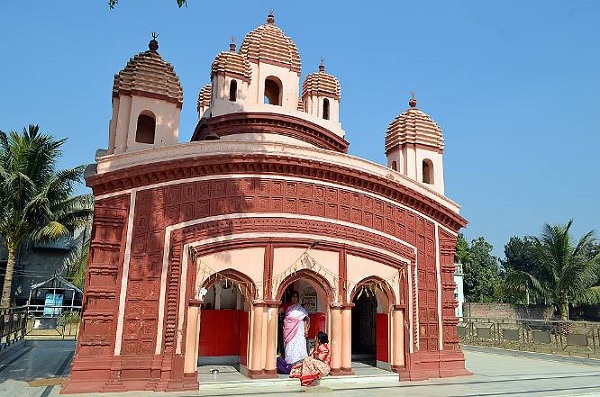
Kankaleshwari Kali Temple – Navaratna Style of Architecture
The temple has the local name Kankal Bari (“House of the skeleton”) alias Rakta Tola (“Blood-Temple”). The temple is set in a square courtyard. It has three adjoining chambers. Kankaleshwari Kali is in the central house, and there are Shivalingas and tridents in the other two. The entrance to the shrine is three arched corresponding to the three rooms. The management committee’s office is in one corner of the courtyard.
The front side of the temple is adorned with Terracotta Sculptures displaying kings, sages, mendicants and family persons. Initially I felt happy; I love Terracotta Sculptures. However, on closer looks, my joy turned pale. The original Terracotta Sculptures are either gone or beyond recognition courtesy new layers of glaring red paints and unimaginative and insensible renovation.
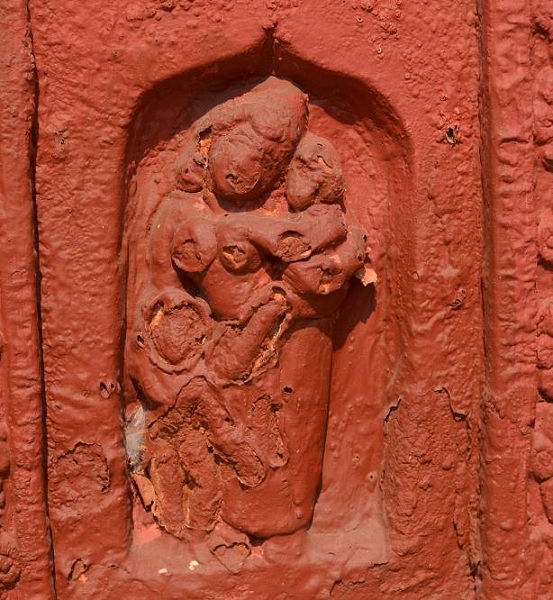
A Terracotta Sculpture that betrays grotesque tampering
There are several local legends and ideas about the temple. No informative board is there. I wonder why Archeological Survey of India has not taken it under protection.
According to one version, the Kankaleshwari Kali Sculpture is more than 2,000 years old. Another version says that the Idol was found during 1700 AD when floodwater receded in the nearby Damodar River. Yet, as per two other versions, the Sculpture was found either in 1916 or 1923; and its dating is yet to be confirmed.
It is evident from above versions that no serious research has yet been done.
When we reached the temple, we found two women devotees. The priest was not present, and the sanctum door of barred-grill was locked. Immediately, I started taking shots through the barred-grill, apprehending that the priest on arrival might not allow us that.
Fortunately, after about 10 minutes, the priest arrived and unlocked the bar. Fortunately again, he did not mind our taking shots from close, though he occasionally looked at me as if trying to understand my childish enthusiasm.
I observed Her carefully.
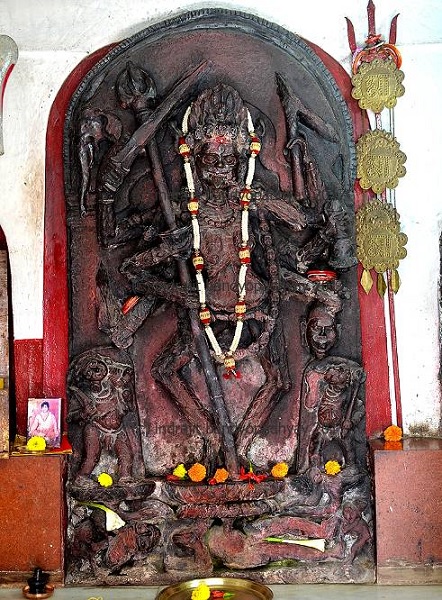
Kankaleshwari Kali
Before understanding Her, we need some idea of traditional depiction of Chamunda whose origin is narrated differently in different Puranas and Texts.
In Devi Mahatmya, She is one of 8 Matrikas who emerged as Chandika Jayasundara from an eyebrow of goddess Kaushiki, a goddess created from "sheath" of Durga and was assigned the task of eliminating the demons Chanda and Munda, generals of demon kings Shumbha-Nishumbha. After Goddess Chandika Jayasundara had killed Chanda and Munda, and took the slain heads to the goddess, Kaushiki was immensely pleased and bestowed upon her the title of “Chamunda". In a later episode of Devi Mahatmya, Durga created the Matrikas, one of whom is Kali. After Kali had sucked all the blood of the demon Raktabija, She is hailed as Chamunda.
In Varaha Purana, Chamunda and Kali are separate Goddesses; and Chamunda appears from the foot of the lion-headed goddess Narshmi. In another version, Chamunda appeared from the frown of Parvati to kill demons Chanda and Munda. In Matsya Purana, Chamunda and the other Matrikas were created by Shiva to help him kill the Andhakasura, who like Raktabija, could regenerate from his dripping blood. In Vishnudharmottara Purana, Chamunda is considered as a manifestation of depravity, and is assigned the direction of south-West or Nairrti.
Thus, in traditional depiction, Chamunda is both form of Kali and a separate Devi. She is variously known as Sachchi Mata, Chamundi, Chamundeshwari, and Charchika in different parts of India. She is also one of the sixty-four or eighty-one Tantrik goddesses called Yoginis, the attendants of the warrior goddess Durga.
Chamunda is often portrayed as haunting cremation grounds or fig trees. Traditionally, She received animal sacrifices along with wine offerings.
As I mentioned earlier, Devi Chamunda is an interesting link of Vedic-Upanishadik and the later Jain culture, because She is one of the Goddesses who found place in Jain pantheon and has been transformed into a Devi who receives vegetarian offerings.
Regarding the origin of Chamunda, one theory proposed by Ramakrishna Gopal Bhandarkar is that She was originally a form of Devi worshipped by the Munda peoples of the Vindhya range of central India. The Munda tribe finds mention in Mahabharata. Her fierce nature also associates Her with Vedic Rudra and Agni. Her socket eyes are intense to burns the evil of all three worlds.
Chamunda’s colour is Black or Red. She wears Mundamala (a garland of severed heads or skulls). She has four, eight, ten or twelve arms, holding a Damaru (drum), Trishula (trident), sword, a snake, Khatvanga (skull-mace), thunderbolt, a severed head and Panapatra (drinking vessel, wine cup) or Kapala (skull-cup), filled with blood.
She stands on a Shava (corpse of a man) or Preta (Ghost) or She sits on a defeated demon or Pretasana (Seat of corpse). Sometimes, Her Vahana (mount or vehicle) is an owl. Bones, skulls, and serpents are Her ornaments. She wears a Yajnopavita (a sacred thread worn by priests and warriors) of skulls. Her Jata Mukuta or headdress is formed of piled, matted hair tied with snakes or skull ornaments. Sometimes, a crescent moon adorns her head. Her companions are bloodthirsty fiends, goblins, skeletons, ghosts and beasts like jackals, which eat corpse-flesh on which Chamunda sits or stands.
Now, our Kankaleshwari Kali both fits and does not fit with those depictions.
She, engraved on a single black Basalt stone, resembles the human skeleton with clearly depicted muscles, bones, vein, and artery. She is no doubt Chamunda in Her Skeletal Form. But what about Her standing on a Lotus that springs from Shiva’s navel? Interestingly, this depiction resembles iconography of Kamakhya because Kamakhya also sits upon a Lotus that emerges from Shiva’s navel. Another resemblance is that, while to each side of Kamakhya sit Brahma and Vishnu, who are each seated upon a lotus, as well; Kankaleshwari has two dwarf figures on Lotus and corpse too on her either side.
The resemblance however, ends there. In case of Kamakhya, Shiva lies atop a lion. Here in Kankaleshwari Kali temple, Shiva lies on the ground with open eyes and with folded palm doing Pranam to Her. Shiva is attended by Ganas at His Head and Feet. The Ganas are obscure human figures; bent in business and deformed. The one at His Feet looks like a nude woman with a vast hair-do, and the one at His Head looks like a long-faced man.
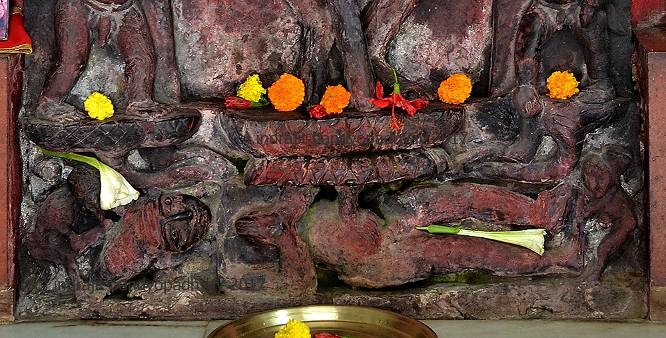
Shiva at Her Foot
Kamakhya is depicted as a young omnipotent, omniscient and omnipresent goddess of 16 years (sodashi), ornately dressed, typically wearing a red Sari, opulent jewelry and red flowers such as hibiscus; holding in each of ten hands a lotus, trident, sword, bell, discus, bow, arrows, club or scepter, goad, and shield, and her remaining two hands holding a bowl made either of gold or a skull; whereas, Kankaleshwari Kali is skeletal, and therefore, looks aged and Death-like.
Among Her four right hands, She holds the Trident two hands, Sword with one hand, and with another a Dagger. Among Her left hands, one holds a Parashu (axe), one a Ghanta (Bell), one a beheaded head of a demon, and another’s forefinger strangely points to Her own Tongue – as if She shows what She has done, and capable of doing.
Hooded snakes form Her Hair, and skulls of birds and beasts form Her hair band. A human face forms the central gem of Her hair band. Bones form Her waistband, and a human skull at the centre of the band covers Her Genitalia.
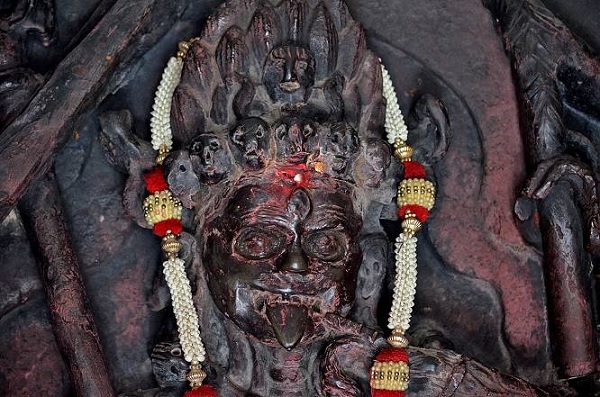
Mother’s Face
There are remarkably sculpted drops - one at Her Upper Lip and another at the tip of Her Tongue. My imagination fails at how the Sculptor-Poet created these drops with transparent appearance.
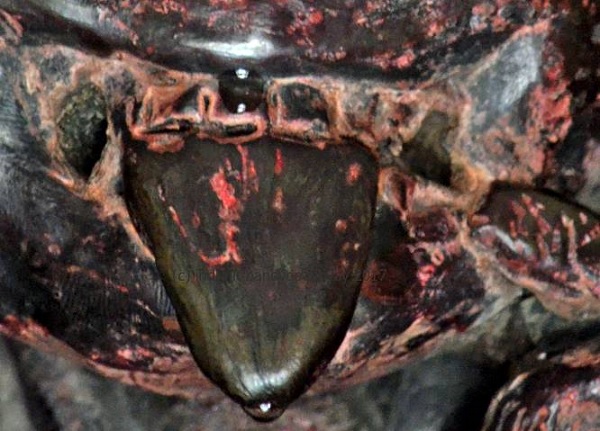
Mother’s Tongue
Regarding Kankaleshwari Kali’s form, I find one unexpected similarity with Sarasvati – rather, our lesser-known Sarasvati who is terrible, of dark complexion and "8" armed.
In RgVeda, Sarasvati is mighty; she “bursts with her strong waves the ridges of the hills” (sanu girinam tavishebhirurmibhih); she slays the Parvatas - paravataghni(6.61.2). The killer-aspect makes her a Devi of War. She is Ghoraa (venerable, awful, sublime, terrific, frightful, terrible, dreadful, violent, and vehement); she rides a golden chariot on a golden path (hiranyavartanih); she is killer of Vrtra - vrtraghni (RV- 6.61.7) like Indra. Her roar is tempestuous (amashcarati roruvat; RV- 6.61.8c).
Sarasvati is Seven-Sistered (saptasvasa) – who are the seven Metres of Vedas or the seven Rivers (RV- 6.61.10); just as Chamunda is one of "8" Matrikas.
The connection of Sarasvati and Krshna (Black/Dark) is first found in RgVeda though in an oblique way. At RgVeda 7.95.1, Rshi Vashishtha Maitra-Varuni regards Sarasvati as their (men’s) sure defense and fort of Iron (esha sarasvati dharunamayasi puh). Iron – Ayasa – is Karshnayasam (Iron/Black Metal) in Mahabharata.
In Shandilya Upanishad, we find an interesting description of Sarasvati. In explaining the sacred syllable OM (AUM), the Rshi states: “The letter ‘M’ has as its visible symbol Sarasvati, an aged woman of black colour riding on a bull, having a trident in her hand (makaramurtih krshnangi vrshabhavahini vrddha/ trishuladharini sarasvati bhavati, 17).” Here, Sarasvati is not only Krshna, her connection with “M” and her appearance as vrddha in the sense “old” associates her with Pralaya – the universal dissolution.
The Buddhist “Sutra of Golden Light” describes Sarasvati as follows: “…because she is the best of lionesses, because she is a vehicle for men, because she is adorned with eight arms, Superior to the best of lionesses, she manifests a human form. As to [her] physique, she has a body adorned with eight arms. Indeed she is superior like the lion among beasts, always self-adorned with eight arms, each holding bow, arrow, sword, longhandled spear, axe, long vajra, iron wheel, and lasso." (second section of stanza five)
This terrible form of Sarasvati is less remembered by us; and in my opinion, Goddess Kali / Chamunda is thus actually Sarasvati’s later Archetype.
Coming back to Kankaleshwari Kali …
The Sculptor-Poet worked on the red-black stone to perfection. He has used the shades of red colour in such a fashion, that stretches of red, light-red and white across and all over Her Body uniquely creates the aura of Her being besmeared with blood and flesh. Red and white bordering Her Teeth, depicts the blood and flesh stuck to Her Teeth and a stain of red and white on Her Tongue, shows that blood is dripping down Her Tongue. Similar shades of red are there in Her skeletal Eyes – making them glare fiercely.
At the back of Her Head, at the background is a large elephant. Elephant, we know, also shares the epithet and eponym Naga.
Her left Foot is grounded, while Her right Toe touches the ground, as if She is in Nrttya (Dance) mood. The dwarf on Her right is naked, and holds a raised dagger in his right hand. He has large earrings, bangles on arms, necklace with prominent beads, and potbelly. He seems to have a dead human body hung on his left shoulder. He bends his head extremely, as if he is wonder-struck at Her. Interestingly, he stands on a lotus leaf whose stem has an unknown origin somewhere on Shiva’s side.
The dwarf on Her left appears to stand on the back and buttock of a corpse. He holds a trident in his left hand, and his right hand fingers touch his face in a gesture of being stunned. These two dwarfs might be Shiva’s Bhairavas.
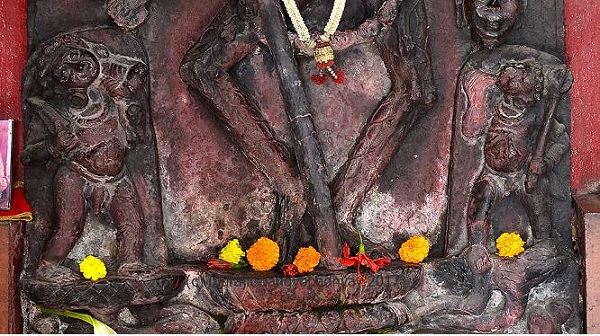
Dwarfs on either side
The overall geometrical patterns of the Sculpture are worth noting and understanding.
Her legs are bent forming triangles, and so are Her coned arms.
Triangles, we know, are symbols of Shiva-Shakti – the upright pyramid signifies the Phallus – the Shiva, and the upturned pyramid symbolizes the Yoni (Womb, Vagina) – the Shakti. So far I have seen and understood Sculptures, these geometrical structures are incorporated in Shiva-Shakti (or, Shiva and Parvati) Sculptures; and their body postures and gestures are so sculpted that we always have the triangles as a recurrent motif.
The skeleton together with angular limbs and body posture symbolizes the nude reality of Life; and these geometric conic patterns are symbols of aggressiveness and conflict – as in graphology. For example, Her sword crosses Her trident forming “x”. Her right forearm and right leg form triangles with the trident. Her right-side is thus concentrated with conflict – clash of Her own right hand arms and domination of triangular and cross-mark geometric patterns on Her right side. In comparison, Her left side is open and spacious; but here hangs a beheaded demon’s head on Her left forearm.
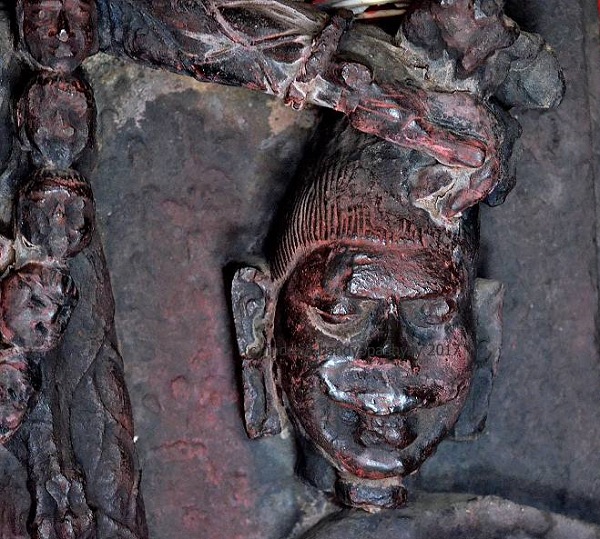
Demon’s Head hanging
Now, the skeletal structure together with the conic limbs makes her appear like Insect – grasshopper, to be specific, and this, I suggest, is significant in understanding Her.
Kali is the Goddess of Subversion of Power. She kills demons – but who are these demons? These demons are Power-Mongers – they are Kama-Centric and Artha-Centric. These demons start well, often from humble origin, often with religious background, often with ascesis; however, once in power, they start considering themselves invincible and begin oppression on their subjects.
There are two three apt idioms in Bengali to describe these creatures – “Dharake Sara Jnana Kara” (Trans: ‘to consider the Earth as a mere earthen utensil/plate’), “Lyaaj Gajano” (Trans: ‘to grow an exclusive Tail’), and “Ki Hanu Re!” (Trans: ‘Lo! What have I become’!).
The symptom is easily recognizable. We often meet these demons in our political masters and in our Ruling Class – in diverse fields of culture or sports.
The point is: the whole of Vedic Philosophy and Puranik Narratives harp again and again that these Creatures will meet their own pathetic ending and turn to dust. Everyone of these creatures are following the same Script, and waiting for same end.
Chamunda will thus never lose Her relevance.
Regarding the imagery of insect …
‘Insect’ is common idiom for beings supposed to be trampled at will; in other words, insect is symbol and metaphor for trivia – the marginalized. Here, She, appearing insect-like subverts that conception, just as She subverts the very concept of Female beauty.
This Centre-Margin play goes on even in the domain of our own Body-Space. The emaciated represents weakness, while muscles or the cover-up of the skeleton is viewed as strength. Chamunda deconstructs that Structure. It is as if, Weakness has shifted from the Margin to assume the Centre – by overpowering demons.
It is for this reason that her terrible form gives hope. She becomes the symbol of every oppressed creatures of the world.
A Sculpture cannot be understood and appreciated unless it is observed minutely, and thereafter contemplated upon. If the Skeleton-form is horrifying, the aesthetics of wonderfully depicted major bones and the arterial veins create a unique drama of Rasas. When one contemplates on Her Skeletal Form, the evoked Bibhatsa and Bhayanaka Rasa is thereafter balanced and cancelled by the aesthetics of the Sculpture and its subtlety.
Devi Kankaleshwari Kali’s form symbolizes the Life of Death – that is, Death and reality of Death as a living being. She is terrifying; yet, contemplation of Her form fills the mind with peace – Shanta Rasa. The peace comes from a sense of all "8" Rasas playing in Her – perhaps symbolized in Her "8" hands too. The calm and tranquility is fostered by a sense of glimpse within the reality of things and Life. Skeleton is a literal reality of our inside, I would say, skeleton is a great leveler. Kankaleshwari Kali with Her skeletal form reminds us of our Reality Within.
There is another shorter Sculpture of Chamunda beside Kankaleshwari Kali which is equally interesting. It is no doubt antique. Together with it, there is one Radha-Krshna Idol of recent make. Though the modern is misfit with the antiques, the ambience carries a message of relevance.
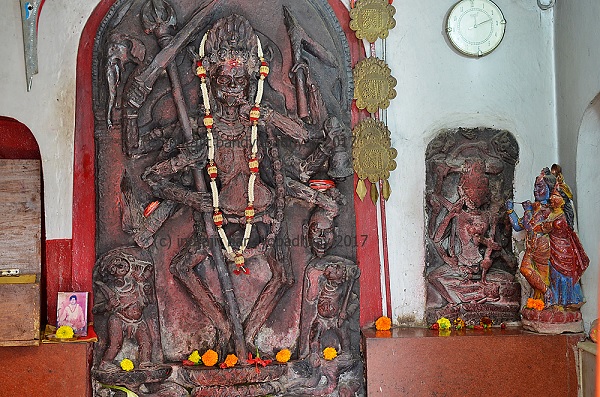
The Sanctum Sanctorum
The Shaktas and Vaishnavas in Bengal have a long tradition of rivalry; however, this Temple has admirably fused the two religious tradition. This fusion is in fact evident in the Kankaleshwari Sculpture. Lotus springing from Shiva’s navel reminds us of Narayana on His Anantasayya, and Brahma sitting on Lotus that springs from Narayana’s navel. Here, in the Kankaleshwari Sculpture, Shiva in Narayana’s role carries the great message of the RgVeda – All Gods are One though called in different names -
indram mitram varunamagnimahuratho divyah sa suparno garutman
ekam sad vipra bahudha vadantyagnim yamam matarishvanamahuh // RV- 1.164.46
The shorter Chamunda Sculpture, much decayed, also deserves special attention.
Here too, She is in Her Skeletal Form. With Her upper right arm, She holds a Khadga that crosses across the back of Her Head. One hand is in Baraabhaya Mudra; one hand points to Her Face, and another holds a sword. With one of Her left hands, She holds a Trident; another hand holds a Lotus in front of Her breast. The other two hands are damaged by ravages of time. Shiva, as Shava (corpse) lies beneath Her.
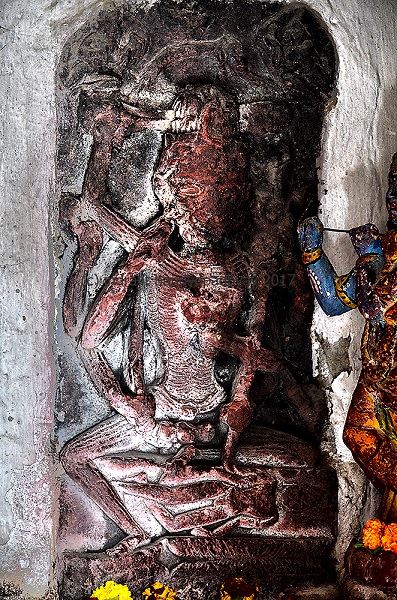
Chamunda in sitting posture
Now, it was our turn to return. The auto driver’s patience had no doubt been tested. He started complaining sulkily, “Sir, you did not say you would stay long…”
Back to reality, then … and back to home after that …
Visiting temples, I often have chances to be sad at one thing. I found the same cause in Kankaleshwari Kali Temple too.
The archaic charm of the Sculpture is tampered by the temple and its glaring colours and cemented construction. Even the Terracotta Sculptures – some of which still bear traces of antiquity have been tampered with gross colours and grotesque reconstruction. The Subtlety is lost, and the new reconstructions lack artistic sense.
Well, they will call it ‘maintenance’; however, it is ‘destruction’ to me. These maintenance-oaalas do not have the imagination and understanding that a piece of living History like this Sculpture with Archeological significance should have been maintained in proper ambience.
These people have also forgotten that Temple-architecture and ambience is integral part of the deity within; Temple is the extension of the Deva or Devi.
I will be happy if the Archeological Survey of India takes the Sculptures under protection. I am reminded of one Chamunda Sculpture of Mahadeva-Kandariya Temple of Khajuraho.
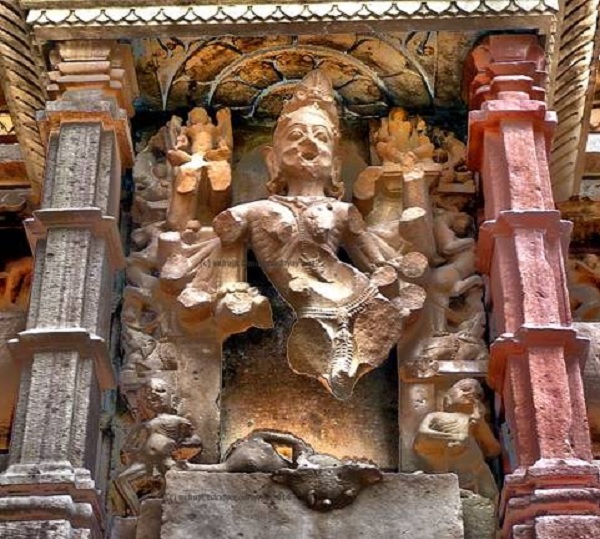
Chamunda, Mahadeva-Kandariya, Khajuraho
I give the picture of Khajuraho Chamunda Sculpture above for readers to think. Khajuraho is world famous justifiably. Doesn’t the Kankaleshwari Kali of Burdwan deserve attention too?
05-Feb-2017
More by : Indrajit Bandyopadhyay

|
"Absolutely mesmerizing! Reading about the Kankaleshwari Kali Mata Temple in Burdwan was such an enriching experience. The way you’ve woven history, culture, and devotion into your writing is truly captivating. I could almost feel the sacred aura of the temple through your words. Thank you for sharing this treasure of knowledge — it not only deepened my understanding of our heritage but also filled me with pride and reverence for our traditions. |

|
Sir thank you for describing the diety in such detail. And for the clear photographs which help us view it. Amazing explanations and references too. |

|
We visited this temple recently,and were dismayed at the Insensitive mishandling of these Ancient Terracotta images.Thankfully, the Deity Inside has been saved from such ' Development '.Thank you ,for your Superlative Explanation and Deep knowledge of Iconography. The Sculptor- Devotee's Depth of Devotion and your Blog - both have been Soul- Satisfying. Immensely Grateful ,to have been born in this land , and to have visited your Blog.More Power to You.জয় মা কালী। |

|
Great review Sir, Sir eye opener We so unaware and ignorant towards are our own,culture ,traditions after all everything has emerged out of our puranas and Vedas which were well sculpted, each sculpture says a story of our rich heritage and treasure of knowledge all unknown to us, which was gifted by our ancestors It seems it the roots are harmed The tree cannot survive long Same is happening with our Indian culture...... Day by day |

|
Very good and excellent reviewing. Thank you... |